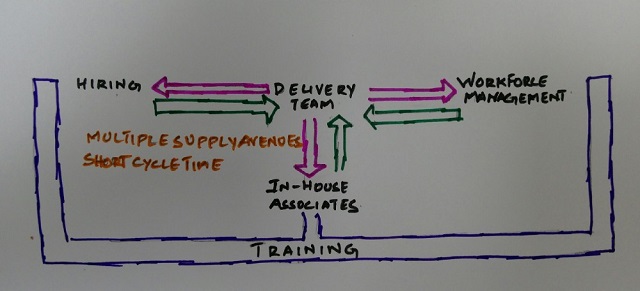Critical to revamp the talent supply model to ensure predictability

We read, watched on news, participated and in some cases even experienced the purge of employees in large numbers from IT / ITES companies in the recent times. Both existing employees and campus students aspiring to get into these IT companies are now a worried lot and are running from pillar to post.
Indian IT folks employed in the US are also not spared. The changes in the Visa/work permit regulations by governments, protectionist economic policies and racist bias, make their lives even more worrisome.
About 30000 associates are reported to lose their jobs in this year. Campus hiring from these companies has gone down by about 40%. The social implications among middle class Indian parents, who paid their life’s savings to get their children qualified and to land them in a ‘Software company’, see them travel to US is now a distant dream.
IT companies experience this situation every few years. And every time, we seem to think, it will last only this year. Sure, we survived over these economic depressions, the last being the 2009 big one. However this one is not driven by economic conditions and that is why this is different. This one is a change that will redefine the way we do IT outsourcing in India. This one will reset the horizon.
Surveys by various industry forums like the ‘World Economic Forum’ have been advocating this change for the past few years. Ever since we started to bank, buy insurance, shop online for everything from daily essentials to fashion, hailing a taxi, to even finding a date, from a mobile phone, we knew this day was coming. Yet we chose not to adapt.
Companies attribute this to the changing requirement in the skills to clients, the projects that are in the offing, changing business models, and policies of countries. We can also blame this situation on things like bad hiring, training teams not able to get trainees production-ready in shorter cycles, re-skilling programs not really effective in organizations, colleges and universities not adapting to changing demand from the industry, and finally associates not taking efforts to re-skill themselves.
Can a talent supply model create a difference to the situation?
All that said, we have to acknowledge the fact that we are left with a large inventory of people with skills that are not relevant or in demand anymore. This makes me wonder – how could our talent supply model have made a difference to this situation? Could we have done something to avoid or lessen the impact? Could we as a part of the talent supply chain made changes in our programs and helped the business and employees?
For the past 30 years or so, since IT and ITES started making news in the Indian economic system, our talent supply model has predominantly been from campus hiring. We would assume that the model would now be mature enough to adapt to these changing demands in a more realistic manner and time frame. Yet the supply sources have not scaled up to this new environment.
Online learning start-ups (Coursera, Udacity and many more) are yet to gain credibility in the Indian context. Universities are yet to wake up to the new set of skill requirements and make changes in their graduation programs. Organizations have to make learning & re-skilling their business priority. But all these will take time to mature and become viable options.
True, we may not hire as we used to (in thousands). But the demand for new skills will continue. If traditional Development, Maintenance and Testing skills are redundant today, the in-demand skills like AI, Analytics, Design, UX & UI will also be redundant in a few years.
Need to relook the talent supply model
We need to relook at our talent supply model that is agnostic of these changing skills and change our supply sources accordingly. We need a talent supply model that is flexible enough and designed to stand the test of changing business dynamics. We need a model that is adaptable and scale adjustable.
To imagine such a model, we first need to understand the current model and its shortcomings. Here is a simple overview of the model that most IT companies follow to meet 80% their talent requirements.

So what’s not working for us in this model?
Dynamic Demand – The average lead time that this model needs to produce resources is at the least 240 days. It is in a way unrealistic to expect business to know their demand so far in advance in this VUCA world. In most cases, the clients themselves looking to outsource their IT requirements may not know this early on.
Skill guarantee by training is still a long way from reality – Even if businesses manage to garner the demand, there is no guarantee that the resource delivered to them will meet the requirement. There is always a 60-90 day period to get the resource embedded into the actual situation and this means burning time and money. Training teams, with all their new age models are yet to deliver a trainee as production ready on day one or week one.
Cost of skill is not buyer driven – The business does not decide what they want to pay for the resource. Cost of training, cost of hiring and many other incidental costs add up. The business manager has to bear the cost of the resource irrespective of what it costs. In today’s project P&L 60% of cost is resource compensation and benefits. Yet the delivery manager has little or no control over it. He is left to play with the balance to make the project profitable.
Leads to a potential large & un-noticed bench – Such a process with no clear ownership on the resources, leads to un-noticed bench which no one knows what to do with. We faced this situation a few times over the years, and our natural response has been to clean it up once every year or two, face some public ire and hope people forget it over time. Well, this time we are stuck with a larger such inventory to clean.
So how can we address these and yet create a model that works?
For a start, we can re-align the center. In this case the business delivery team. The team that uses these resources to deliver client requirements should be the one that sets priorities and benchmarks. They are the buyer and it should be a buyer’s market to be effective and prosper.
Imagine a market place. A talent market place, where the business can pick up the resources based on the requirement, when they need them, evaluate them on their own and deploy them.
All talent management functions like ‘Workforce management’ ‘Hiring’, ‘Training’ and even the individual resources compete among each other to provide what the business requires. The business in turn picks up the most skilled, readily available, cost-effective resource that they feel comfortable with.
Something like this below.

So what will happen in such a model?
Shorter & closer to actual demand - Business will raise their demand closer to the actual project and will probably have better clarity on the skills required. With better knowledge of delivery commitments and other contractual obligations, demand is more likely to be closer to accurate.
Competing suppliers will automatically start changing their internal processes to ensure their supply gets picked up for skill, delivery date, cost and other parameters that a business wants. Cost of hiring, training, re-skilling and supply sources will change based on the demand.
Businesses will only pick candidates they are confident of delivery. Incubation period tends to be shorter and hence time to bill will have shorter cycles.
Scale agnostic – Suppliers will now be very inventory conscious and develop models to meet changing demand in a more efficient manner.
How a model should be?
The model has its own ambiguity and set of challenges. Some of these ‘Initiatives’ or activities are already in place in most organizations. However they are not aligned the right way for the right reasons in today’s context. We need to re-align them and connect the dots.
A model needs to grow over a period of time. Am sure, the current linear process model also had its fair share of challenges, and it still does. But we managed it and overcame a few over the years. The market place model will also grow over years.
In my opinion, the merits outweigh the challenges. For this model to work, it needs a change in the way organizations are structured, rethink the traditional metrics that are mapped for each function, and re-deign the way we think talent supply. Re-design it with project delivery teams at the center.
This does not mean we stop doing things to improve our hiring & training capabilities. I only suggest a change in the model of talent supply. Effective supply sources for any model is a different debate altogether. The ability to change the way we hire, train, and deploy in the new digital age is a different yet exciting challenge to re-imagine.
Conclusion
Our existing model needs a change, not because it did not change for the past few years, but for its ability to make an impact on business, and actually move from a support function to a business enabler. Sure the road is hard. This displaces the comfort levels that we already have in the existing model, threatens the importance and in some cases the very existence of some of the departments and functions.
I may not have answers to all the challenges or road blocks that this model brings. The underlying theme is to bring that change. Change the way we think talent supply to truly make a difference and keep Indian IT Industry ahead of the rest of the countries.













